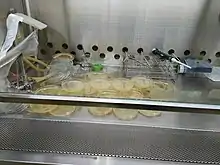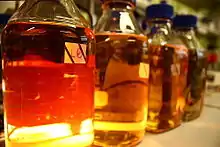Lysogeny broth
Lysogeny broth (LB) is a nutritionally rich medium primarily used for the growth of bacteria. Its creator, Giuseppe Bertani, intended LB to stand for lysogeny broth,[1] but LB has also come to colloquially mean Luria broth, Lennox broth, or Luria–Bertani medium. The formula of the LB medium was published in 1951 in the first paper of Bertani on lysogeny. In this article he described the modified single-burst experiment and the isolation of the phages P1, P2, and P3. He had developed the LB medium to optimize Shigella growth and plaque formation.[1][2]


LB media formulations have been an industry standard for the cultivation of Escherichia coli as far back as the 1950s.[3][4][5][6][7] These media have been widely used in molecular microbiology applications for the preparation of plasmid DNA and recombinant proteins. It continues to be one of the most common media used for maintaining and cultivating laboratory recombinant strains of Escherichia coli.[8] For physiological studies however, the use of LB medium is to be discouraged.[9]
There are several common formulations of LB. Although they are different, they generally share a somewhat similar composition of ingredients used to promote growth, including the following:
- Peptides and casein peptones
- Vitamins (including B vitamins)
- Trace elements (e.g. nitrogen, sulfur, magnesium)
- Minerals
Sodium ions for transport and osmotic balance are provided by sodium chloride. Tryptone is used to provide essential amino acids such as peptides and peptones to the growing bacteria, while the yeast extract is used to provide a plethora of organic compounds helpful for bacterial growth. These compounds include vitamins and certain trace elements.
In his original 1951 paper, Bertani used 10 grams of NaCl and 1 gram of glucose per 1 L of solution; Luria in his "L broth" of 1957 copied Bertani's original recipe exactly.[6] Recipes published later have typically left out the glucose.
Formulae
The formulations generally differ in the amount of sodium chloride, thus providing selection of the appropriate osmotic conditions for the particular bacterial strain and desired culture conditions. The low salt formulations, Lennox and Luria, are ideal for cultures requiring salt-sensitive antibiotics.
- LB-Miller (10 g/L NaCl)
- LB-Lennox (5 g/L NaCl)
- LB-Luria (0.5 g/L NaCl)
Preparation

The following is a common method for the preparation of 1 litre of LB:
- Measure out the following:
- 10 g tryptone
- 5 g yeast extract
- 10 g NaCl
- Suspend the solids in ~800 ml of distilled or deionized water.
- Add further distilled water or deionized water, in a measuring cylinder to ensure accuracy, to make a total of 1 liter.
- Autoclave at 121 °C for 20 mins.
- After cooling, swirl the flask to ensure mixing, and the LB is ready for use.
Adjusting the pH
Prior to autoclaving, some labs adjust the pH of LB to 7.5 or 8 with sodium hydroxide. However, sodium hydroxide does not provide any buffering capacity to the media, and this result in rapid changes to the pH during bacteria cultivation. To get around this some labs prefer to adjust the pH with 5-10 mmol/L TRIS buffer, diluted from 1 mol/l TRIS stock at the desired pH. However, it is not absolutely necessary to adjust the pH for most situations. Some labs adjust the pH to 7.0 merely as a precaution.
Since the buffering with Tris will also be largely ineffective in the face of substantial bacterial growth, adjusting the pH of LB in this particular manner is usually unnecessary. As such, use of Tris in some broth recipes (especially when the culture will be stored at room temperature conditions for extended periods of time) may be considered a superstitious procedure without much scientific merit.
See also
- Agar plate
- Salvador Luria
- SOC medium—another widely used medium for culture of Escherichia coli in molecular biology work
References
- Bertani, G. (2004). "Lysogeny at mid-twentieth century: P1, P2, and other experimental systems". Journal of Bacteriology. 186 (3): 595–600. doi:10.1128/JB.186.3.595-600.2004. PMC 321500. PMID 14729683.
- Bertani, G (1951). "Studies on lysogenesis. I. The mode of phage liberation by lysogenic Escherichia coli". J. Bacteriol. 62 (3): 293–300. PMC 386127. PMID 14888646.
- Miller, J. H. (1972). Experiments in molecular genetics. Cold Spring Harbor Laboratory, Cold Spring Harbor, New York.
- Luria, S. E.; Adams, J. N.; Ting, R. C. (1960). "Transduction of lactose-utilizing ability among strain of E. coli and S. dysenteriae and the properties of the transducing phage particles". Virology. 12 (3): 348–390. doi:10.1016/0042-6822(60)90161-6. PMID 13764402.
- Lennox, E. S. (1955). "Transduction of linked genetic characters of the host by bacteriophage P1". Virology. 1 (2): 190–206. doi:10.1016/0042-6822(55)90016-7. PMID 13267987.
- Luria, S. E.; Burrous, J. W. (1957). "Hybridization between Escherichia coli and Shigella". J. Bacteriol. 74 (4): 461–476. PMC 289941. PMID 13475269.
- Anderson, E. H. (1946). "Growth requirement of virus-resistant mutants of Escherichia coli strain B". Proc. Natl. Acad. Sci. USA. 32 (5): 120–128. doi:10.1073/pnas.32.5.120. PMC 1078898. PMID 16588724.
- Sambrook, J., E. F. Fritsch, and T. Maniatis. (1989). Molecular cloning: a laboratory manual, 2nd edition. Cold Spring Harbor Laboratory, Cold Spring Harbor, New York.
- Nikaido, H. (2009). The Limitations of LB Medium. Small things considered - The Microbe Blog. ASM. http://schaechter.asmblog.org/schaechter/2009/11/the-limitations-of-lb-medium.html